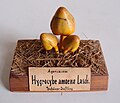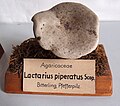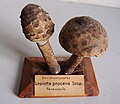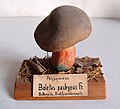Category:Botanical Museum Greifswald
Jump to navigation
Jump to search
museum | |||||
| Upload media | |||||
| Instance of |
| ||||
|---|---|---|---|---|---|
| Part of | |||||
| Location | Greifswald, Western Pomerania | ||||
| Founded by | |||||
| Inception |
| ||||
| official website | |||||
 | |||||
| |||||
Media in category "Botanical Museum Greifswald"
The following 200 files are in this category, out of 213 total.
(previous page) (next page)-
Modell der Blüte von Pisum sativum (Erbse) -Brendel Nr. 10- (2).jpg 2,736 × 3,648; 2.09 MB
-
Modell der Blüte von Pisum sativum (Erbse) -Brendel Nr. 10-.jpg 2,736 × 3,648; 4.84 MB
-
Modell der Blüte von Prunus cerasus (Sauerkirsche, Weichsel) -Brendel Nr.15- (2).jpg 3,648 × 2,736; 2.1 MB
-
Modell der Blüte von Prunus cerasus (Sauerkirsche, Weichsel) -Brendel Nr.15-.jpg 3,036 × 2,628; 4.66 MB
-
Modell der Blüte von Ribes grossularia (Ribes uva-crispa, Stachelbeere) -Brendel Nr. 11-.jpg 2,538 × 3,084; 5.68 MB
-
Modell der Blüte von Solanum tuberosum (Kartoffel) -Brendel Nr. 10- (2).jpg 3,648 × 2,736; 2.29 MB
-
Modell der Blüte von Solanum tuberosum (Kartoffel) -Brendel Nr. 10-.jpg 2,736 × 3,648; 5.94 MB
-
Modell der Blüte von Solanum tuberosum (Kartoffel) -Osterloh Nr.16- (2).jpg 2,736 × 3,648; 1.52 MB
-
Modell der Blüte von Solanum tuberosum (Kartoffel) -Osterloh Nr.16-.jpg 2,166 × 3,120; 4.73 MB
-
Modell der Blüte von Symphytum officinale (Echter Beinwell) -Osterloh Nr.36-.jpg 1,818 × 2,868; 3.07 MB
-
Modell der Blüte von Tulipa gesneriana (Garten-Tulpe) -Osterloh Nr. 124-.jpg 2,274 × 3,372; 5.03 MB
-
Modell der Blütenzapfen von Pinus silvestris (Kiefer) -Osterloh Nr.25- (4).jpg 3,648 × 2,736; 286 KB
-
Modell der Blütenzapfen von Pinus silvestris (Kiefer) -Osterloh Nr.25-.jpg 2,736 × 3,648; 1.45 MB
-
Modell der Frucht von Taxus baccata (Europäische Eibe) -Osterloh Nr. 68-.jpg 2,364 × 3,400; 4.57 MB
-
Modell der Hülse von Pisum sativum (Erbse) (2).jpg 2,736 × 3,648; 1.46 MB
-
Modell der Hülse von Pisum sativum (Erbse) (3).jpg 2,736 × 3,648; 1.37 MB
-
Modell der Hülse von Pisum sativum (Erbse) (4).jpg 3,648 × 2,736; 2.03 MB
-
Modell der Hülse von Pisum sativum (Erbse).jpg 2,304 × 3,108; 4.64 MB
-
Modell der Keimung der Dicotyledonen (Zweikeimblättrige) -Brendel Nr. 2-.jpg 2,900 × 2,240; 4.49 MB
-
Modell der männlichen Blüte von Taxus baccata (Europäische Eibe) -Osterloh Nr. 66-.jpg 2,028 × 3,500; 4.42 MB
-
Modell der Tetradenbildung aus einer Mutterzelle -Brendel Nr. 155- (2).jpg 2,736 × 3,648; 1.26 MB
-
Modell der Tetradenbildung aus einer Mutterzelle -Brendel Nr. 155- (3).jpg 3,648 × 2,736; 2.1 MB
-
Modell der Tetradenbildung aus einer Mutterzelle -Brendel Nr. 155-.jpg 2,200 × 3,164; 4.64 MB
-
Modell der weiblichen Blüte von Taxus baccata (Europäische Eibe) -Osterloh Nr. 67-.jpg 2,736 × 3,648; 4.88 MB
-
Modell der Ährchen von Secale cereale (Roggen) -Brendel Nr. 8-.jpg 2,736 × 3,648; 5.46 MB
-
Modell der Ährchen von Triticum vulgare (Weizen) -Brendel Nr. 7-.jpg 2,736 × 3,648; 5.31 MB
-
Modell der Ährchen von Triticum vulgare (Weizen) -Osterloh Nr. 4-.jpg 2,010 × 3,546; 4.15 MB
-
Modell des Antherididums von Marchantia polymorpha -Brendel Nr. 139-.jpg 2,736 × 3,648; 1.69 MB
-
Modell des Archegoniums von Marchantia polymorpha -Brendel Nr. 141-.jpg 2,736 × 3,648; 1.53 MB
-
Modell des Aspidiums von filix mas II.jpg 2,736 × 3,432; 5.5 MB
-
Modell des Aspidiums von filix mas.jpg 3,560 × 2,736; 5.19 MB
-
Modell des männlichen Huts von Marchantia polymorpha -Brendel Nr. 138-.jpg 2,736 × 3,648; 2.12 MB
-
Modell des Pollensacks von Pinus silvestris (Kiefer) -Osterloh Nr. 24- (3).jpg 3,648 × 2,736; 290 KB
-
Modell des Pollensacks von Pinus silvestris (Kiefer) -Osterloh Nr. 24- (4).jpg 2,736 × 3,648; 5.54 MB
-
Modell des Sporangiums von Pteris serrulata -Brendel Nr. 64- (2).jpg 2,736 × 3,648; 1.21 MB
-
Modell des Sporangiums von Pteris serrulata -Brendel Nr. 64- (3).jpg 2,736 × 3,648; 1.21 MB
-
Modell des Sporangiums von Pteris serrulata -Brendel Nr. 64- (4).jpg 2,736 × 3,648; 1.63 MB
-
Modell des Sporangiums von Pteris serrulata -Brendel Nr. 64-.jpg 2,154 × 3,084; 4.44 MB
-
Modell einer Blüte von Fabaceae (Hülsenfrüchtler) (2).jpg 3,648 × 2,736; 1.95 MB
-
Modell einer Blüte von Fabaceae (Hülsenfrüchtler) (3).jpg 3,648 × 2,736; 2.05 MB
-
Modell einer Blüte von Fabaceae (Hülsenfrüchtler).jpg 1,988 × 2,384; 2.98 MB
-
Modell einer männlichen Blüte von Pinus silvestris (Kiefer) -Osterloh Nr.23- (3).jpg 2,736 × 3,648; 4.5 MB
-
Modell einer männlichen Blüte von Quercus pedunculara (Sommereiche) -Osterloh Nr. 35-.jpg 1,836 × 3,180; 4.08 MB
-
Modell einer Röhrenblüte von Helianthus annuus (Sonnenblume) (2).jpg 450 × 600; 42 KB
-
Modell einer Röhrenblüte von Helianthus annuus (Sonnenblume) (3).jpg 3,648 × 2,736; 285 KB
-
Modell einer Röhrenblüte von Helianthus annuus (Sonnenblume).jpg 2,322 × 3,582; 5.36 MB
-
Modell einer Zungenblüte.jpg 2,788 × 2,348; 4.22 MB
-
Modell eines behöften Tüpfels von Pinus sylvestris -Brendel Nr. 156-.jpg 2,352 × 3,456; 4.8 MB
-
Modell eines Korns von Triticum vulgare (Weizen) -Osterloh Nr. 138- (2).jpg 3,004 × 2,592; 5.53 MB
-
Modell eines Korns von Triticum vulgare (Weizen) -Osterloh Nr. 138-.jpg 3,648 × 2,736; 6.5 MB
-
Modell von Aconitum napellus (Blauer Eisenhut) -Osterloh Nr. 105-.jpg 2,736 × 3,648; 5.58 MB
-
Modell von Agaricus campestris (Wiesenchampignon, Feld-Edelpilz) (2).jpg 3,648 × 2,736; 2.18 MB
-
Modell von Agaricus campestris (Wiesenchampignon, Feld-Edelpilz).jpg 3,152 × 2,440; 5.54 MB
-
Modell von Agrostemma Githago (Kornrade).jpg 2,358 × 3,183; 5.29 MB
-
Modell von Albatrellus pes-caprae (Polyporus pes caprae, Ziegenfußporling).jpg 3,416 × 2,548; 5.99 MB
-
Modell von Amanita muscaria (Fliegenpilz, Fliegenschwamm).jpg 3,456 × 2,736; 5.13 MB
-
Modell von Amanita pantherina (Pantherpilz).jpg 2,628 × 2,356; 4.24 MB
-
Modell von Amanita rubescens (Perlpilz, Rötender Wulstling oder Fleischchampignon).jpg 3,072 × 2,704; 5.51 MB
-
Modell von Armillaria mellea (Gemeiner Hallimasch, Goldgelbe Hallimasch).jpg 3,090 × 2,562; 4.8 MB
-
Modell von Arum (Aronstab) -Brendel Nr. 202-.jpg 2,016 × 3,648; 5.76 MB
-
Modell von Aspergillus (Gießkannenschimmel) -Osterloh- -Brendel 10f-.jpg 2,664 × 2,736; 4.65 MB
-
Modell von Avena sativa (Hafer), Ährchen -Osterloh Nr.1- (2).jpg 3,648 × 2,736; 319 KB
-
Modell von Avena sativa (Hafer), Ährchen -Osterloh Nr.1- (3).jpg 2,148 × 3,354; 4.46 MB
-
Modell von Avena sativa (Hafer), Ährchen -Osterloh Nr.1-.jpg 450 × 600; 39 KB
-
Modell von Berberis vulgaris (Gewöhnliche Berberitze) -Osterloh Nr. 161-.jpg 2,424 × 3,469; 5.56 MB
-
Modell von Beta vulgaris (Rübe) -Osterloh Nr. 131-.jpg 2,394 × 3,510; 4.56 MB
-
Modell von Boletus edulis Bull. (Gemeiner Steinpilz, Stein-Röhrling).jpg 2,736 × 3,030; 5.04 MB
-
Modell von Boletus elegans (Goldröhrling) (2).jpg 3,648 × 2,736; 1.98 MB
-
Modell von Boletus elegans (Goldröhrling).jpg 2,632 × 2,560; 4.37 MB
-
Modell von Boletus luteus (Suillus luteus, Butterröhrling, Butterpilz).jpg 2,884 × 2,508; 4.68 MB
-
Modell von Boletus satanas (Satansröhrling, Satanspilz) (2).jpg 2,736 × 3,648; 1.52 MB
-
Modell von Boletus satanas (Satansröhrling, Satanspilz).jpg 3,648 × 2,736; 6.24 MB
-
Modell von Boletus variegatus (Sandpilz, Hirsepilz).jpg 3,648 × 2,736; 2.09 MB
-
Modell von Brassica (Raps).jpg 3,648 × 2,736; 2.04 MB
-
Modell von Brassica napus (Raps) (2).jpg 2,736 × 3,648; 2.1 MB
-
Modell von Brassica napus (Raps) -Brendel Nr. 3-.jpg 2,688 × 3,210; 5.38 MB
-
Modell von Brassica napus (Raps) -Osterloh- (2).jpg 2,744 × 2,708; 4.52 MB
-
Modell von Brassica napus (Raps) -Osterloh-.jpg 450 × 600; 40 KB
-
Modell von Brassica napus (Raps).jpg 2,640 × 2,736; 4.51 MB
-
Modell von Campanula rotundifolia (Rundblättrige Glockenblume) -Osterloh Nr. 103-.jpg 2,430 × 3,648; 5.11 MB
-
Modell von Cantharellus cibarius (Pfifferling, Eierschwamm, Rehling).jpg 3,476 × 2,500; 5.48 MB
-
Modell von Clavaria (Keulchen).jpg 2,118 × 3,270; 4.09 MB
-
Modell von Claviceps purpurea (Mutterkorn, keimend) -Osterloh Nr.41- (2).jpg 2,334 × 3,498; 3.76 MB
-
Modell von Claviceps purpurea (Mutterkornpilz) -Osterloh Nr. 42- -Brendel 10 g, 2- (2).jpg 2,736 × 3,648; 5.34 MB
-
Modell von Clitopilus prunulus (Mehlräsling, Mehlpilz, Mehlschaum oder Pflaumenpilz).jpg 3,648 × 2,736; 5.88 MB
-
Modell von Corylus avellana (Haselnuss), männliche Schuppe -Osterloh Nr.63- (2).jpg 3,648 × 2,736; 342 KB
-
Modell von Corylus avellana (Haselnuss), weibliche Blütenschuppe -Osterloh Nr. 118-.jpg 2,034 × 3,474; 4.63 MB
-
Modell von Digitalis purpurea (Roter Fingerhut) -Osterloh Nr. 82-.jpg 2,736 × 2,754; 4.61 MB
-
Modell von Drosera (Sonnentau) -Brendel Nr. 130-.jpg 2,736 × 2,994; 4.96 MB
-
Modell von Equisetum (Schachtelhalm) -Brendel Nr. 2-.jpg 2,544 × 3,648; 4.94 MB
-
Modell von Equisetum limosum (Schachtelhalm) -Brendel Nr. 62-.jpg 2,688 × 3,420; 5.08 MB
-
Modell von Equisetum limosum (Schachtelhalm) -Brendel Nr. 63-.jpg 2,424 × 3,534; 4.79 MB
-
Modell von Ficus carica (Echte Feige) -Brendel Nr. 136-.jpg 2,888 × 2,736; 4.76 MB
-
Modell von Fragaria vesca (Walderdbeere) -Brendel Nr. 35-.jpg 2,736 × 3,648; 5.25 MB
-
Modell von Geranium pratense (Wiesen-Storchschnabel) -Osterloh Nr. 121-122-.jpg 2,496 × 3,648; 6.07 MB
-
Modell von Helianthus annuus (Sonnenblume) -Osterloh Nr. 10-.jpg 2,004 × 3,648; 4.85 MB
-
Modell von Hydnum repandum (Semmel-Stoppelpilz).jpg 3,312 × 2,644; 4.55 MB
-
Modell von Hygrocybe amoena (Schöner Saftling).jpg 3,104 × 2,668; 4.05 MB
-
Modell von Hygrocybe punicea (Granatroter Saftling, Granatrote oder Größte Saftling).jpg 3,100 × 2,272; 4.68 MB
-
Modell von Hypholoma Sublateritium (Ziegelroter Schwefelkopf).jpg 3,648 × 2,332; 4.81 MB
-
Modell von Inocybe rimosa (Kegeliger Risspilz).jpg 2,836 × 2,488; 4.3 MB
-
Modell von Inoloma traganum.jpg 2,180 × 2,404; 3.38 MB
-
Modell von Iris germanica (Deutsche Schwertlilie) -Osterloh Nr. 127-.jpg 2,736 × 3,648; 5.25 MB
-
Modell von Lactarius blennius (Graugrüner Milchling).jpg 2,032 × 2,168; 2.88 MB
-
Modell von Lactarius fuliginosus (Überrusster Milchling).jpg 2,568 × 2,736; 3.94 MB
-
Modell von Lactarius piperatus (Langstieliger Pfeffer-Milchling) (2).jpg 3,648 × 2,736; 2.23 MB
-
Modell von Lactarius piperatus (Langstieliger Pfeffer-Milchling).jpg 2,874 × 2,538; 5.46 MB
-
Modell von Lactarius pyrogalus (Scharfer Haselmilchling) (2).jpg 3,648 × 2,736; 2.15 MB
-
Modell von Lactarius pyrogalus (Scharfer Haselmilchling).jpg 2,580 × 2,736; 4.52 MB
-
Modell von Lactarius scrobiculatus Scop. (Grubiger Milchling, Strohgelber Milchling).jpg 3,320 × 2,484; 5.36 MB
-
Modell von Lactarius turpis (Olivbrauner Milchling, Tannenreizker) (2).jpg 3,648 × 2,736; 1.86 MB
-
Modell von Lactarius turpis (Olivbrauner Milchling, Tannenreizker).jpg 3,648 × 2,736; 1.91 MB
-
Modell von Lactarius volemus (Brätling, Breitling, Milchreizker).jpg 2,952 × 2,256; 4.29 MB
-
Modell von Lamium purpureum (Purpurrote Taubnessel), Blüte -Osterloh Nr.19-.jpg 2,292 × 3,204; 4.23 MB
-
Modell von Linum usitatissimum (Gemeiner Lein) -Brendel Nr. 5-.jpg 2,736 × 3,312; 5.61 MB
-
Modell von Linum usitatissimum (Gemeiner Lein).jpg 2,736 × 3,360; 5.19 MB
-
Modell von Lycoperdon bovista (Gemeiner Bovist, Stäubling).jpg 2,504 × 2,540; 3.86 MB
-
Modell von Macrolepiota procera Scop. (Lepiota procera, Parasolpilz, Riesenschirmpilz).jpg 3,020 × 2,628; 4.46 MB
-
Modell von Marchantia polymorpha, Brutbecher mit Brutknospen -Brendel Nr. 142-.jpg 2,736 × 3,648; 5.09 MB
-
Modell von Marchantia polymorpha, Brutknospe -Brendel Nr. 148-.jpg 2,382 × 3,648; 5.6 MB
-
Modell von Marchantia polymorpha, ganzer weiblicher Hut -Brendel Nr. 140-.jpg 2,670 × 3,408; 5.14 MB
-
Modell von Marchantia polymorpha, Sporangium -Brendel Nr. 144-.jpg 2,388 × 3,648; 5.44 MB
-
Modell von Mnium cuspidatum -Brendel Nr. 191-.jpg 3,188 × 2,736; 5.05 MB
-
Modell von Mnium cuspidatum -Brendel Nr. 192-.jpg 2,364 × 3,648; 4.99 MB
-
Modell von Mucor mucedo (Köpfchenschimmel) -Osterloh- -Brendel 10e-.jpg 3,056 × 2,576; 4.76 MB
-
Modell von Nepenthes distillatoria (Kannenpflanze).jpg 2,736 × 3,648; 5.37 MB
-
Modell von Oidium tuckeri (Echter Mehltau) -Osterloh- -Brendel 101-.jpg 2,736 × 3,648; 5.64 MB
-
Modell von Orchis militaris (Helm-Knabenkraut) -Osterloh-.jpg 2,736 × 3,648; 5.87 MB
-
Modell von Phallus impudicus (Stinkmorchel).jpg 2,754 × 2,430; 4.15 MB
-
Modell von Pholiota adiposa (Schleimiger Schüppling, Goldfell) (2).jpg 3,648 × 2,736; 2.04 MB
-
Modell von Pholiota adiposa (Schleimiger Schüppling, Goldfell).jpg 3,216 × 2,640; 4.64 MB
-
Modell von Phytophthora infestans -Osterloh- -Brendel 10 k, 2-.jpg 3,288 × 2,372; 4.78 MB
-
Modell von Pinus silvestris(Kiefer) -Brendel Nr.16-.jpg 2,736 × 3,096; 5.12 MB
-
Modell von Pisum sativum (Erbse) -Brendel Nr. 6- (2).jpg 2,238 × 3,582; 4.55 MB
-
Modell von Pisum sativum (Erbse) -Brendel Nr. 6- (3).jpg 2,736 × 3,648; 1.45 MB
-
Modell von Pisum sativum (Erbse) -Brendel Nr. 6- (4).jpg 3,648 × 2,736; 2.14 MB
-
Modell von Pisum sativum (Erbse) -Brendel Nr. 6-.jpg 2,240 × 3,132; 3.41 MB
-
Modell von Polyporus ovinus (Albatrellus ovinus, Schafporling oder Schafeuter) (2).jpg 3,648 × 2,736; 2.2 MB
-
Modell von Polyporus ovinus (Albatrellus ovinus, Schafporling oder Schafeuter).jpg 3,648 × 2,736; 5.89 MB
-
Modell von Primula officinalis (Primula veris, Echte Schlüsselblume) (2).jpg 2,736 × 3,648; 2.02 MB
-
Modell von Primula officinalis (Primula veris, Echte Schlüsselblume).jpg 2,388 × 3,504; 5.16 MB
-
Modell von Prunus avium - Prunus cerasus (Kirschbaum) -Osterloh Nr. 30- (2).jpg 2,556 × 3,072; 4.99 MB
-
Modell von Prunus avium - Prunus cerasus (Kirschbaum) -Osterloh Nr. 30- (3).jpg 3,648 × 2,736; 2.07 MB
-
Modell von Prunus avium - Prunus cerasus (Kirschbaum) -Osterloh Nr. 30-.jpg 2,736 × 3,090; 4.91 MB
-
Modell von Pteris serrulata -Brendel Nr. 65- (2).jpg 2,736 × 3,648; 1.42 MB
-
Modell von Pteris serrulata -Brendel Nr. 65-.jpg 2,436 × 3,252; 5.55 MB
-
Modell von Pteris serrulata.jpg 2,514 × 2,790; 4.69 MB
-
Modell von Puccinia graminis (Getreiderost) -Osterloh- -Brendel 10 h, 1- (2).jpg 3,648 × 2,736; 1.99 MB
-
Modell von Puccinia graminis (Getreiderost) -Osterloh- -Brendel 10 h, 1-.jpg 2,520 × 3,486; 6.29 MB
-
Modell von Puccinia graminis (Getreiderost) -Osterloh- -Brendel 10 h, 2-.jpg 3,356 × 2,456; 5.78 MB
-
Modell von Quercus robur (Quercus pedunculata, Stieleiche) -Brendel Nr. 10-.jpg 2,466 × 3,468; 5.75 MB
-
Modell von Rosa canina (Hunds-Rose) -Osterloh Nr. 126-.jpg 2,736 × 3,132; 4.83 MB
-
Modell von Rubus idaeus (Himbeere) -Osterloh Nr. 80-.jpg 2,208 × 3,354; 4.55 MB
-
Modell von Russula lepida (Russula rosea, Harter Zinnober-Täubling) (2).jpg 3,648 × 2,736; 1.97 MB
-
Modell von Russula lepida (Russula rosea, Harter Zinnober-Täubling).jpg 3,052 × 2,516; 4.68 MB
-
Modell von Salix alba (Silber-Weide) -Brendel Nr.19- (2).jpg 2,736 × 3,648; 1.61 MB
-
Modell von Salix alba (Silber-Weide) -Brendel Nr.19-.jpg 2,082 × 3,420; 5.04 MB
-
Modell von Salvia officinalis (Echter Salbei) (2).jpg 2,736 × 3,648; 1.41 MB
-
Modell von Salvia officinalis (Echter Salbei).jpg 2,064 × 3,096; 4.04 MB
-
Modell von Sarracenia (Schlauchpflanzen) -Brendel Nr. 133- (2).jpg 2,736 × 3,648; 1.47 MB
-
Modell von Sarracenia (Schlauchpflanzen) -Brendel Nr. 133-.jpg 1,856 × 2,464; 3.08 MB
-
Modell von Secale cereale (Roggen) -Brendel Nr. 1-.jpg 2,448 × 3,366; 5.96 MB
-
Modell von Siliqua brassicae napi -Brendel Nr. 2-.jpg 1,260 × 3,036; 3.03 MB
-
Modell von Suillus bovinus (Boletus bovinus, Kuhpilz, Ochsenreische, Kuh-Röhrling).jpg 3,052 × 2,456; 4.38 MB
-
Modell von Taraxacum officinale (Gewöhnlicher Löwenzahn) -Osterloh Nr.123-.jpg 2,736 × 3,648; 662 KB
-
Modell von Taxus baccata (Europäische Eibe) -Brendel Nr. 18-.jpg 2,564 × 3,204; 5.01 MB
-
Modell von Tricholoma gambosum (Maipilz) (2).jpg 3,648 × 2,736; 2.07 MB








































































































































































































